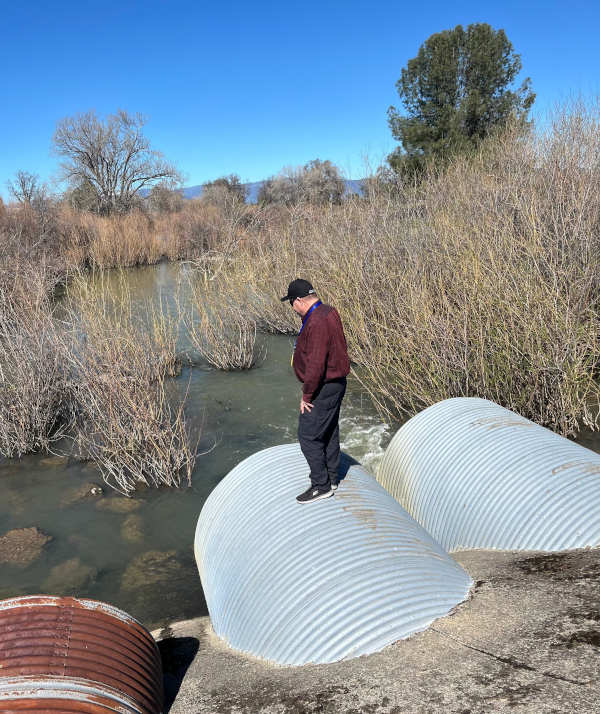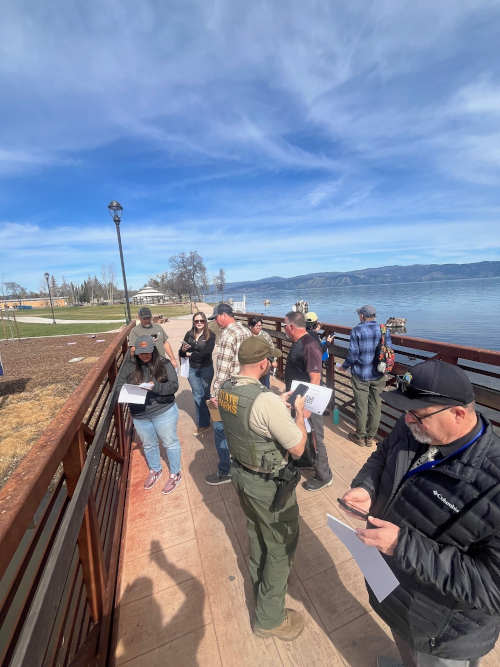
LAKE COUNTY, Calif. — As the weather warms and the Clear Lake hitch begins its annual spawn, trained community members are heading to local creeks to observe the threatened species and collect data as part of a community science program.
This year, 31 residents have volunteered to be part of the Community Science Hitch Spawner Observation Survey organized by the Lake County Watershed Protection District, in collaboration with California Department of Fish and Wildlife, or the CDFW.
Each volunteer has adopted at least one preselected observation site and is committed to monitoring the site every week on a chosen day for 10 consecutive weeks, starting the week of March 9.
The observation points are spread throughout the county, from Burns Valley Creek to Schindler Creek, Clayton Creek to Scotts Creek, totaling 33 public sites and two private property-sponsored sites, covering a wide range of local tributaries.
The volunteers have attended mandatory training sessions, including in-class and on-field components. They learned how to identify hitch — distinguishing them from other fish in the local streams such as the Sacramento sucker — as well as how to observe environmental factors and use the Survey 123 system to report their findings.
This program of community science is “a form of research that provides everyone, regardless of their background, an opportunity to contribute meaningful data to further our scientific understanding of key issues,” said Chris Childers of Lake County Water Resources — who is one of the hitch program coordinators — during a public presentation on March 13.
Childers noted that the volunteers this year came all from “over the board” in terms of their backgrounds, including a district supervisor, a park ranger, tribal members and agricultural community members
Such community outreach and involvement play a crucial part in hitch preservation, Childers said.
“The more we can get the community involved, and the more we can educate them about these fish, the better the restoration is going to go in the future,” he said. “If nobody knows about this fish, then nobody’s going to care, right?”
Childers said this is the program’s first year and that it will continue annually.

Reporting hitch activity, scientifically
State and local agencies such as the CDFW, Lake County Water Resources, Habematolel Pomo of Upper Lake and Robinson Rancheria all have their own hitch monitoring and surveying programs. Most of them are conducted by hitch experts.
The community observation survey, however, is designed for public participation.
“Theirs is much simpler. I just want 10 weeks of data collection; I just want to know if hitches are present and how many of them are there. So I made it very, very easy for them,” Childers explained in a phone call, adding that the expert version of hitch survey is “more technical.”
“We collect water quality, which means, dissolved oxygen and temperature and pH — these kinds of parameters,” he said. “But for the community scientists, a water quality probe can be anywhere from $5,000 to $30,000 right? I'm not gonna expect people to purchase that kind of equipment.”
Yet, the community scientists make meaningful contributions to monitoring relative hitch population trends over time that will help with “long term management decisions” related to the hitch, Childers said in his presentation.
Such monitoring is beneficial because “we want to see [hitch] presence/absence before and after creek restoration projects and barrier removal efforts,” he said.
Data collected from the volunteers across the sites will also help answer key questions such as: When do hitch enter specific creeks? How long do they remain in each creek?

Observations from the field
“The first two weeks, I didn’t see any hitch,” said District 4 Supervisor Brad Rasmussen, who is also a volunteer. “And then this week, on Monday, I observed 25 hitches from the observation point.”
Rasmussen’s site is Adobe Creek at Bill Hill Road. He has chosen Sunday as his observation day and usually arrives at noon. But it is OK to deviate by a day, he mentioned, recalling from the training he received.
Childers said that reporting from a day before or after the chosen day is “not a problem.” But going to the site on the same day is the ideal.
“To keep it standardized, the same day is what we’re asking for,” said Childers. “That’s how you eliminate bias from a survey.”
Rasmussen also learned that it is recommended to go to the site between 10 a.m and 4 p.m. because “the sun’s higher and it’s easier to see on the water.”
The observers have been trained to be precise in their reporting.
“I did see more hitch up above the observation point,” said Rasmussen. “But when you’re doing the data entry, you know you have to just report what is from the survey point that you’re assigned.”
So he reported 25 hitches for his site last week with pictures of the fish and the environment. As required, he also uploaded pictures he took of the downstream and upstream from where he stood.
When it comes to identifying hitch in the creek, Rasmussen said he was very confident.
“So that's part of the training to learn what the difference is. And once you learn that, you can easily identify,” he said.
“I’m interested in the hitch and what’s happening with them,” said Rasmussen of why he volunteered. “And also, just to help support the program.”
In fact, the community scientists are asked to report information more than just the number of hitches they see.
They can report mortalities — if they see dead fish, or anything alarming such as trash or oil on the water, Childers explained.
Childers said he was “amazed” and “impressed” by the data quality from the first few weeks’ reporting.
“Just everything that came in the reports were very similar to what I have been seeing in the creeks right now,” he said.
“It could go south or it could go well,” Childers said, referring to the uncertainties surrounding this first-time program. “And it’s going well. So our department is really, really happy about everything that’s going on.”
Email staff reporter Lingzi Chen at
Hitch video by Rebecca Harper of the Lake County Farm Bureau.

 How to resolve AdBlock issue?
How to resolve AdBlock issue? 



